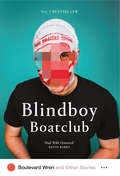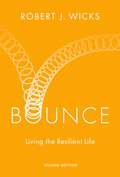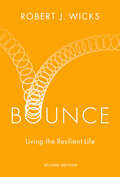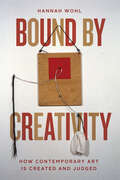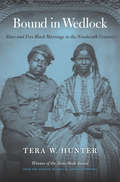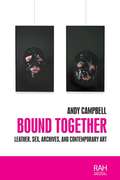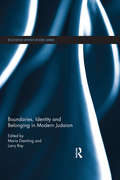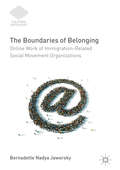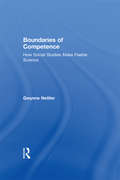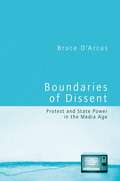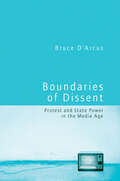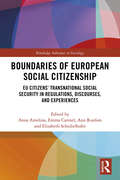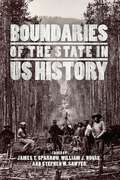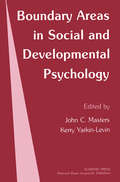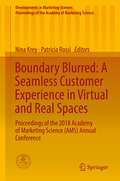- Table View
- List View
Boulevard Wren and Other Stories
by Blindboy BoatclubBoulevard Wren and Other Stories is the stunning follow-up to the bestselling Gospel According to Blindboy, and a warped mirror held up to the Irish psyche.Provocative and unsettling, the stories rove through the centuries, from the barren fields of Famine-struck Meath to the chaotic landscape of the near future, where social media has colonised the deepest recesses of the human subconscious. This is a world populated by characters lost and at odds with the demands of contemporary life, for whom the line separating redemption and madness has grown impossibly fine.Razor-sharp social satire, it is an era-defining work from one of Ireland’s most anarchic satirists and a quietly devastating portrait of a society in disarray.
Bounce: Living the Resilient Life
by Robert J. WicksEnriching the balance and meaning of life by better understanding stress and creating your own self-care protocol, Bounce shows you how to live life to the fullest. People are naturally drawn to information on how to improve self-care, create a richer circle of friends, develop and maintain a healthy perspective, and, especially now, the importance of seeing "alone-time" not simply as forced isolation but a venue for new personality development. This aids self-awareness and understanding and improves emotional intellect so we don't react but instead pause to reflect and process life as it unfolds. The original edition of Bounce addressed these areas but then came Covid-19, intense political strife, and increased divisiveness within countries, families, communities, and even faith traditions. The need to greet, successfully adjust to, and even benefit from, such unexpected and broad-reaching change, personally threatening challenges, and stress is of even greater importance now. In addition, styles of living which were taken for granted, such as adults going to work and children educated in an actual classroom, were also radically impacted. As a result, adults were also expected to quickly adapt in order to deal with the questions raised by the young about their own security and hoped-for normalcy. With updated information and a new chapter on post-traumatic growth (PTG), the second edition of Bounce is designed to enhance the search for balance and new meaning to live life to the fullest.
Bounce: Living the Resilient Life
by Robert J. WicksEnriching the balance and meaning of life by better understanding stress and creating your own self-care protocol, Bounce shows you how to live life to the fullest. People are naturally drawn to information on how to improve self-care, create a richer circle of friends, develop and maintain a healthy perspective, and, especially now, the importance of seeing "alone-time" not simply as forced isolation but a venue for new personality development. This aids self-awareness and understanding and improves emotional intellect so we don't react but instead pause to reflect and process life as it unfolds. The original edition of Bounce addressed these areas but then came Covid-19, intense political strife, and increased divisiveness within countries, families, communities, and even faith traditions. The need to greet, successfully adjust to, and even benefit from, such unexpected and broad-reaching change, personally threatening challenges, and stress is of even greater importance now. In addition, styles of living which were taken for granted, such as adults going to work and children educated in an actual classroom, were also radically impacted. As a result, adults were also expected to quickly adapt in order to deal with the questions raised by the young about their own security and hoped-for normalcy. With updated information and a new chapter on post-traumatic growth (PTG), the second edition of Bounce is designed to enhance the search for balance and new meaning to live life to the fullest.
Bound by Creativity: How Contemporary Art Is Created and Judged
by Hannah WohlWhat is creativity? While our traditional view of creative work might lead us to think of artists as solitary visionaries, the creative process is profoundly influenced by social interactions even when artists work alone. Sociologist Hannah Wohl draws on more than one hundred interviews and two years of ethnographic research in the New York contemporary art market to develop a rich sociological perspective of creativity. From inside the studio, we see how artists experiment with new ideas and decide which works to abandon, destroy, put into storage, or exhibit. Wohl then transports readers into the art world, where we discover how artists’ understandings of their work are shaped through interactions in studio visits, galleries, international art fairs, and collectors’ homes. Bound by Creativity reveals how artists develop conceptions of their distinctive creative visions through experimentation and social interactions. Ultimately, we come to appreciate how judgment is integral to the creative process, both resulting in the creation of original works while also limiting an artist’s ability to break new ground. Exploring creativity through the lens of judgment sheds new light on the production of cultural objects, markets, and prestige.
Bound by Creativity: How Contemporary Art Is Created and Judged
by Hannah WohlWhat is creativity? While our traditional view of creative work might lead us to think of artists as solitary visionaries, the creative process is profoundly influenced by social interactions even when artists work alone. Sociologist Hannah Wohl draws on more than one hundred interviews and two years of ethnographic research in the New York contemporary art market to develop a rich sociological perspective of creativity. From inside the studio, we see how artists experiment with new ideas and decide which works to abandon, destroy, put into storage, or exhibit. Wohl then transports readers into the art world, where we discover how artists’ understandings of their work are shaped through interactions in studio visits, galleries, international art fairs, and collectors’ homes. Bound by Creativity reveals how artists develop conceptions of their distinctive creative visions through experimentation and social interactions. Ultimately, we come to appreciate how judgment is integral to the creative process, both resulting in the creation of original works while also limiting an artist’s ability to break new ground. Exploring creativity through the lens of judgment sheds new light on the production of cultural objects, markets, and prestige.
Bound in Wedlock: Slave and Free Black Marriage in the Nineteenth Century
by Tera W. HunterTera W. Hunter offers the first comprehensive history of African American marriage in the nineteenth century and into the Jim Crow era. She reveals the practical ways couples adopted, adapted, or rejected white Christian ideas of marriage, creatively setting their own standards for conjugal relationships under conditions of uncertainty and cruelty.
Bound together: Leather, sex, archives, and contemporary art (Rethinking Art's Histories)
by Andy CampbellWhat are the archives of gay and lesbian leather histories, and how have contemporary artists mined these archives to create a queer politics of the present? This book sheds light on an area long ignored by traditional art history and LGBTQ studies, examining the legacies of the visual and material cultures of US leather communities. It discusses the work of contemporary artists such as Patrick Staff, Dean Sameshima, Monica Majoli, AK Burns and AL Steiner, and the artist collective Die Kränken, showing how archival histories and contemporary artistic projects might be applied in a broader analysis of LGBTQ culture and norms. Hanky codes, blurry photographs of Tom of Finland drawings, a pin sash weighted down with divergent histories – these become touchstones for writing leather histories.
Bound together: Leather, sex, archives, and contemporary art (Rethinking Art's Histories)
by Andy CampbellWhat are the archives of gay and lesbian leather histories, and how have contemporary artists mined these archives to create a queer politics of the present? This book sheds light on an area long ignored by traditional art history and LGBTQ studies, examining the legacies of the visual and material cultures of US leather communities. It discusses the work of contemporary artists such as Patrick Staff, Dean Sameshima, Monica Majoli, AK Burns and AL Steiner, and the artist collective Die Kränken, showing how archival histories and contemporary artistic projects might be applied in a broader analysis of LGBTQ culture and norms. Hanky codes, blurry photographs of Tom of Finland drawings, a pin sash weighted down with divergent histories – these become touchstones for writing leather histories.
Boundaries, Identity and belonging in Modern Judaism (Routledge Jewish Studies Series)
by Larry Ray Maria DiemlingThe drawing of boundaries has always been a key part of the Jewish tradition and has served to maintain a distinctive Jewish identity. At the same time, these boundaries have consistently been subject to negotiation, transgression and contestation. The increasing fragmentation of Judaism into competing claims to membership, from Orthodox adherence to secular identities, has brought striking new dimensions to this complex interplay of boundaries and modes of identity and belonging in contemporary Judaism. Boundaries, Identity and Belonging in Modern Judaism addresses these new dimensions, bringing together experts in the field to explore the various and fluid modes of expressing and defining Jewish identity in the modern world. Its interdisciplinary scholarship opens new perspectives on the prominent questions challenging scholars in Jewish Studies. Beyond simply being born Jewish, observance of Judaism has become a lifestyle choice and active assertion. Addressing the demographic changes brought by population mobility and ‘marrying out,’ as well as the complex relationships between Israel and the Diaspora, this book reveals how these shifting boundaries play out in a global context, where Orthodoxy meets innovative ways of defining and acquiring Jewish identity. This book is essential reading for students and scholars of Jewish Studies, as well as general Religious Studies and those interested in the sociology of belonging and identities.
Boundaries, Identity and belonging in Modern Judaism (Routledge Jewish Studies Series)
by Larry Ray Maria DiemlingThe drawing of boundaries has always been a key part of the Jewish tradition and has served to maintain a distinctive Jewish identity. At the same time, these boundaries have consistently been subject to negotiation, transgression and contestation. The increasing fragmentation of Judaism into competing claims to membership, from Orthodox adherence to secular identities, has brought striking new dimensions to this complex interplay of boundaries and modes of identity and belonging in contemporary Judaism. Boundaries, Identity and Belonging in Modern Judaism addresses these new dimensions, bringing together experts in the field to explore the various and fluid modes of expressing and defining Jewish identity in the modern world. Its interdisciplinary scholarship opens new perspectives on the prominent questions challenging scholars in Jewish Studies. Beyond simply being born Jewish, observance of Judaism has become a lifestyle choice and active assertion. Addressing the demographic changes brought by population mobility and ‘marrying out,’ as well as the complex relationships between Israel and the Diaspora, this book reveals how these shifting boundaries play out in a global context, where Orthodoxy meets innovative ways of defining and acquiring Jewish identity. This book is essential reading for students and scholars of Jewish Studies, as well as general Religious Studies and those interested in the sociology of belonging and identities.
The Boundaries of Belonging: Online Work of Immigration-Related Social Movement Organizations (Cultural Sociology)
by Bernadette Nadya JaworskyThis book addresses an issue currently making political headlines in the United States—immigration. Immigrants have long engendered debates about the boundaries of belonging, with some singing their praises and others warning of their dangers. In particular, the 11 million unauthorized immigrants in the country provoke heated disagreements with issues of legality and morality at the forefront. Increasingly, such debates take place online, by organizations in the immigrant rights and the immigration control movements, who engage in symbolic work that includes blurring, crossing, maintaining, solidifying, and shifting the boundaries of belonging. Based on data collected from 29 national-level groups, this book features a cultural sociological analysis of the online materials deployed by social movement organizations debating immigration in the United States.
Boundaries of Competence: Knowing the Social with Science
by Gwynne Nettler"The term ""social science"" promises more than its practitioners can deliver: it promises knowledge. This knowledge is to consist of statements of empirical regularities of such quality as will enhance predictive power and inform public and private policy. Boundaries of Competence illuminates obstacles to this aspiration.Chapter 1 grounds knowledge in perception. Chapter 2 challenges the assumption that ordinary language necessarily describes reality and reveals the mischief words can do. Chapter 3 proposes a continuum of perceiving-conceiving involved in different ways of ""knowing"" worlds. Chapter 4 lays out requirements of measurement, arguing that assigning numbers to dubious observations gives false assurance that mathematical manipulations necessarily rep- resent events.Chapter 5 shows how choice of unit affects the correlations we find in our search for causes. Chapter 6 holds that, given deficiencies in knowledge and perhaps because of the way Nature works, we assess probabilities rather than seek certainties. Chapter 7 notes difficulties in counting events that consist of ""social facts,"" which ""depend on us,"" and those that refer to ""brute facts,"" that exist independently of us. Chapter 8 criticizes the practice of employing proxies for observations of what we're talking about. In particular, it demonstrates the error produced by relying on what people say as measure of what they do.Chapter 9 criticizes ways of explaining conduct by characterizing actors and their acts, and by ""understanding"" them through empathy. Chapter 10 discusses the important and never-ending quarrel about causation. Chapters 11 and 12 argue that in social affairs, decision is regularly torn between doing what is effective (rational) and doing what is right (moral).Nettler's writing is crisp, and his argument balanced. He employs research from several disciplines to challenge ideologically driven descriptions of our condition and explanations of ou"
Boundaries of Competence: Knowing the Social with Science
by Gwynne Nettler"The term ""social science"" promises more than its practitioners can deliver: it promises knowledge. This knowledge is to consist of statements of empirical regularities of such quality as will enhance predictive power and inform public and private policy. Boundaries of Competence illuminates obstacles to this aspiration.Chapter 1 grounds knowledge in perception. Chapter 2 challenges the assumption that ordinary language necessarily describes reality and reveals the mischief words can do. Chapter 3 proposes a continuum of perceiving-conceiving involved in different ways of ""knowing"" worlds. Chapter 4 lays out requirements of measurement, arguing that assigning numbers to dubious observations gives false assurance that mathematical manipulations necessarily rep- resent events.Chapter 5 shows how choice of unit affects the correlations we find in our search for causes. Chapter 6 holds that, given deficiencies in knowledge and perhaps because of the way Nature works, we assess probabilities rather than seek certainties. Chapter 7 notes difficulties in counting events that consist of ""social facts,"" which ""depend on us,"" and those that refer to ""brute facts,"" that exist independently of us. Chapter 8 criticizes the practice of employing proxies for observations of what we're talking about. In particular, it demonstrates the error produced by relying on what people say as measure of what they do.Chapter 9 criticizes ways of explaining conduct by characterizing actors and their acts, and by ""understanding"" them through empathy. Chapter 10 discusses the important and never-ending quarrel about causation. Chapters 11 and 12 argue that in social affairs, decision is regularly torn between doing what is effective (rational) and doing what is right (moral).Nettler's writing is crisp, and his argument balanced. He employs research from several disciplines to challenge ideologically driven descriptions of our condition and explanations of ou"
Boundaries of Dissent: Protest and State Power in the Media Age
by Bruce D'ArcusBoundaries of Dissent looks at the way that political protest, as it is shaped through the space-time collapsing power of media, questions national identity and state authority. Through this lens of protest politics, Bruce D'Arcus examines how public and private space is symbolically mediated-the way that power and dissent are articulated in the contemporary media.
Boundaries of Dissent: Protest and State Power in the Media Age
by Bruce D'ArcusBoundaries of Dissent looks at the way that political protest, as it is shaped through the space-time collapsing power of media, questions national identity and state authority. Through this lens of protest politics, Bruce D'Arcus examines how public and private space is symbolically mediated-the way that power and dissent are articulated in the contemporary media.
Boundaries of European Social Citizenship: EU Citizens’ Transnational Social Security in Regulations, Discourses and Experiences (Routledge Advances in Sociology #1)
by Anna Amelina Emma Carmel Ann Runfors Elisabeth ScheibelhoferThis edited collection contributes to studies of intra-EU migration and mobility, welfare, and European social citizenship by focusing on transnational labour movements from new to the old EU member states (Hungary–Austria, Bulgaria–Germany, Poland–UK and Estonia–Sweden). The volume provides a comparative analysis of formal organization and mobile individuals’ use of European social security coordination, which involves mobile Europeans' access to and portability of social security rights from the sending to the receiving country (and back). The book discloses the selectivity criteria of welfare provision in four areas (unemployment, family benefits, health insurance, and pensions) that lay at heart of European cross-border social security governance. It also identifies specific discourses of belonging (gendered, ethnicized/racialized and class-related images of ‘Us’ and ‘Them’) that frame the institutional selectivity by constructing images of mobile EUcitizens' ‘deserving’ or ‘non-deserving’ social membership. The collection offers a detailed examination of inequality experiences mobile EU citizens from the new EU countries encounter while accessing and porting social security rights across borders. It will be of interest to a wide range of social science and interdisciplinary researchers, students, and practitioners as well as those interested in intra-EU migration and mobility, social security, European social citizenship, and transnational studies.
Boundaries of European Social Citizenship: EU Citizens’ Transnational Social Security in Regulations, Discourses and Experiences (Routledge Advances in Sociology #1)
by Anna Amelina Emma Carmel Ann Runfors Elisabeth ScheibelhoferThis edited collection contributes to studies of intra-EU migration and mobility, welfare, and European social citizenship by focusing on transnational labour movements from new to the old EU member states (Hungary–Austria, Bulgaria–Germany, Poland–UK and Estonia–Sweden). The volume provides a comparative analysis of formal organization and mobile individuals’ use of European social security coordination, which involves mobile Europeans' access to and portability of social security rights from the sending to the receiving country (and back). The book discloses the selectivity criteria of welfare provision in four areas (unemployment, family benefits, health insurance, and pensions) that lay at heart of European cross-border social security governance. It also identifies specific discourses of belonging (gendered, ethnicized/racialized and class-related images of ‘Us’ and ‘Them’) that frame the institutional selectivity by constructing images of mobile EUcitizens' ‘deserving’ or ‘non-deserving’ social membership. The collection offers a detailed examination of inequality experiences mobile EU citizens from the new EU countries encounter while accessing and porting social security rights across borders. It will be of interest to a wide range of social science and interdisciplinary researchers, students, and practitioners as well as those interested in intra-EU migration and mobility, social security, European social citizenship, and transnational studies.
Boundaries of the State in US History
by James T. Sparrow, William J. Novak, and Stephen W. Sawyer William J. Novak Stephen W. SawyerThe question of how the American state defines its power has become central to a range of historical topics, from the founding of the Republic and the role of the educational system to the functions of agencies and America’s place in the world. Yet conventional histories of the state have not reckoned adequately with the roots of an ever-expanding governmental power, assuming instead that the American state was historically and exceptionally weak relative to its European peers. Here, James T. Sparrow, William J. Novak, and Stephen W. Sawyer assemble definitional essays that search for explanations to account for the extraordinary growth of US power without resorting to exceptionalist narratives. Turning away from abstract, metaphysical questions about what the state is, or schematic models of how it must work, these essays focus instead on the more pragmatic, historical question of what it does. By historicizing the construction of the boundaries dividing America and the world, civil society and the state, they are able to explain the dynamism and flexibility of a government whose powers appear so natural as to be given, invisible, inevitable, and exceptional.
Boundaries of the State in US History
by James T. Sparrow, William J. Novak, and Stephen W. Sawyer William J. Novak Stephen W. SawyerThe question of how the American state defines its power has become central to a range of historical topics, from the founding of the Republic and the role of the educational system to the functions of agencies and America’s place in the world. Yet conventional histories of the state have not reckoned adequately with the roots of an ever-expanding governmental power, assuming instead that the American state was historically and exceptionally weak relative to its European peers. Here, James T. Sparrow, William J. Novak, and Stephen W. Sawyer assemble definitional essays that search for explanations to account for the extraordinary growth of US power without resorting to exceptionalist narratives. Turning away from abstract, metaphysical questions about what the state is, or schematic models of how it must work, these essays focus instead on the more pragmatic, historical question of what it does. By historicizing the construction of the boundaries dividing America and the world, civil society and the state, they are able to explain the dynamism and flexibility of a government whose powers appear so natural as to be given, invisible, inevitable, and exceptional.
Boundaries of the State in US History
by James T. Sparrow, William J. Novak, and Stephen W. Sawyer William J. Novak Stephen W. SawyerThe question of how the American state defines its power has become central to a range of historical topics, from the founding of the Republic and the role of the educational system to the functions of agencies and America’s place in the world. Yet conventional histories of the state have not reckoned adequately with the roots of an ever-expanding governmental power, assuming instead that the American state was historically and exceptionally weak relative to its European peers. Here, James T. Sparrow, William J. Novak, and Stephen W. Sawyer assemble definitional essays that search for explanations to account for the extraordinary growth of US power without resorting to exceptionalist narratives. Turning away from abstract, metaphysical questions about what the state is, or schematic models of how it must work, these essays focus instead on the more pragmatic, historical question of what it does. By historicizing the construction of the boundaries dividing America and the world, civil society and the state, they are able to explain the dynamism and flexibility of a government whose powers appear so natural as to be given, invisible, inevitable, and exceptional.
Boundaries of the State in US History
by James T. Sparrow William J. Novak Stephen W. SawyerThe question of how the American state defines its power has become central to a range of historical topics, from the founding of the Republic and the role of the educational system to the functions of agencies and America’s place in the world. Yet conventional histories of the state have not reckoned adequately with the roots of an ever-expanding governmental power, assuming instead that the American state was historically and exceptionally weak relative to its European peers. Here, James T. Sparrow, William J. Novak, and Stephen W. Sawyer assemble definitional essays that search for explanations to account for the extraordinary growth of US power without resorting to exceptionalist narratives. Turning away from abstract, metaphysical questions about what the state is, or schematic models of how it must work, these essays focus instead on the more pragmatic, historical question of what it does. By historicizing the construction of the boundaries dividing America and the world, civil society and the state, they are able to explain the dynamism and flexibility of a government whose powers appear so natural as to be given, invisible, inevitable, and exceptional.
Boundaries of the State in US History
by James T. Sparrow William J. Novak Stephen W. SawyerThe question of how the American state defines its power has become central to a range of historical topics, from the founding of the Republic and the role of the educational system to the functions of agencies and America’s place in the world. Yet conventional histories of the state have not reckoned adequately with the roots of an ever-expanding governmental power, assuming instead that the American state was historically and exceptionally weak relative to its European peers. Here, James T. Sparrow, William J. Novak, and Stephen W. Sawyer assemble definitional essays that search for explanations to account for the extraordinary growth of US power without resorting to exceptionalist narratives. Turning away from abstract, metaphysical questions about what the state is, or schematic models of how it must work, these essays focus instead on the more pragmatic, historical question of what it does. By historicizing the construction of the boundaries dividing America and the world, civil society and the state, they are able to explain the dynamism and flexibility of a government whose powers appear so natural as to be given, invisible, inevitable, and exceptional.
Boundaries of the State in US History
by James T. Sparrow William J. Novak Stephen W. SawyerThe question of how the American state defines its power has become central to a range of historical topics, from the founding of the Republic and the role of the educational system to the functions of agencies and America’s place in the world. Yet conventional histories of the state have not reckoned adequately with the roots of an ever-expanding governmental power, assuming instead that the American state was historically and exceptionally weak relative to its European peers. Here, James T. Sparrow, William J. Novak, and Stephen W. Sawyer assemble definitional essays that search for explanations to account for the extraordinary growth of US power without resorting to exceptionalist narratives. Turning away from abstract, metaphysical questions about what the state is, or schematic models of how it must work, these essays focus instead on the more pragmatic, historical question of what it does. By historicizing the construction of the boundaries dividing America and the world, civil society and the state, they are able to explain the dynamism and flexibility of a government whose powers appear so natural as to be given, invisible, inevitable, and exceptional.
Boundary Areas in Social and Developmental Psychology
by John C. Masters Kerry Yarkin-LevinBoundary Areas in Social and Developmental Psychology is based largely on the proceedings of a conference at Vanderbilt University in June 1981. One of the goals is to highlight some examples of research that illustrate facets of the important boundary area between social and developmental psychology. The book opens with a chapter that deals with the broad issues of boundary areas in psychology, ending with specific consideration of the boundary between social and developmental psychology. This is followed by separate chapters that consider general propositions regarding the importance of integrating concepts and methods from social and developmental psychology in the study of social relationships; show how integrating social and developmental considerations can assist in the understanding of relationships between parents and children; and apply developmental and social concepts to identify and study some of the aspects of the marital relationship that may lead to its dissolution. Subsequent chapters deal with boundary area issues focusing primarily on children's social behavior. These include the complexity of social processes inherent in children's peer relationships and the role of social exchange processes in social relationships from infancy to adulthood.
Boundary Blurred: Proceedings Of The 2018 Academy Of Marketing Science (ams) Annual Conference (Developments In Marketing Science: Proceedings Of The Academy Of Marketing Science Ser.)
by Nina Krey Patricia Rossi“We see our customers as invited guests to a party, and we are the hosts. It’s our job every day to make every important aspect of the customer experience a little bit better.” Jeff Bezos, Founder and CEO of Amazon.com This proceedings volume explores the ways in which marketers can learn about customers through big data and other sources to create an enhanced customer experience. Consumers today do not simply demand engaging online or offline experiences anymore; they increasingly focus on one seamless experience throughout their journey across virtual and real spaces. While shopping in a physical store, consumers are checking their smart phones for customer reviews and competitive information, and catching a Pokémon or two at the same time. Online experience is no longer only about price shopping and convenience, and offline is no longer only about SKUs. Individual channels matter less and less; it is the omni-channel experience that is becoming main-stream. Marketers need to keep pace and continually adapt and contribute to the changing consumer landscape. Through countless touchpoints across different channels and media, marketers today can learn more about their customers and are better equipped than ever to provide them with a desired augmented experience: easy, fun, engaging, and efficient. Featuring the full proceedings from the 2018 Academy of Marketing Science (AMS) Annual Conference held in New Orleans, Louisiana, this volume provides ground-breaking research from scholars and practitioner from around the world that will help marketers continue to engage their customers in this new landscape. Founded in 1971, the Academy of Marketing Science is an international organization dedicated to promoting timely explorations of phenomena related to the science of marketing in theory, research, and practice. Among its services to members and the community at large, the Academy offers conferences, congresses, and symposia that attract delegates from around the world. Presentations from these events are published in this Proceedings series, which offers a comprehensive archive of volumes reflecting the evolution of the field. Volumes deliver cutting-edge research and insights, complementing the Academy’s flagship journals, the Journal of the Academy of Marketing Science (JAMS) and AMS Review. Volumes are edited by leading scholars and practitioners across a wide range of subject areas in marketing science.
